Icknield Way Morris Men is a Cotswold Morris Dancing team based in Wantage, Oxfordshire. [1] As a member of the Morris Ring, [2] Icknield Way's members are all male.
Icknield Way Morris Men is a Cotswold Morris Dancing team based in Wantage, Oxfordshire. [1] As a member of the Morris Ring, [2] Icknield Way's members are all male.
Icknield Way Morris Men was formed by pupils at Icknield School in Wantage, who approached their music teacher Mary Shunn in September 1958, looking for ideas for an after-school club. [3] Mary had an interest in traditional English dancing and was friends with active dancers, including members of William Kimber's family and Jim Phillips, squire of the Morris Ring from 1958 to 1960. She taught dances from the Headington tradition along with these other dancers.
Icknield Way Morris Men celebrated its 50th anniversary in 2009 with a tour along the Icknield Way ancient highway. [4]
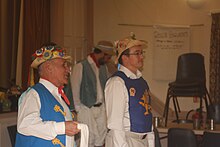
The uniform of Icknield Way's dancers has changed significantly over time but has always been based on "whites", the traditional white trousers and shirt of Cotswold Morris dancers. The uniform has always featured a Wessex wyvern, [5] the symbol of Icknield School. The wyvern currently appears in orange and yellow on the back of a sky blue waistcoat worn over the shirt. Dancers also wear straw hats adorned with ribbons, flowers and badges, along with red spotted neckerchiefs. [6] Video footage of Oxford's May Day celebration shows that this kit has remained fundamentally unchanged since at least 1997. [7]
For the team's 50th anniversary tour, Icknield Way was joined by a side of "old boys" dancing in earlier incarnations of the uniform. The old boys' kit features a yellow wyvern on either a dark blue waistcoat or tabard, depending on the age of the uniform.
Icknield Way members meet to practise every Wednesday in the Scout Hut at Grove, Oxfordshire during the winter months. Between May and September, they dance out on Wednesdays at pubs in the Vale of White Horse and surrounding area. Like many Morris Dancing teams, Icknield Way holds an annual "ale", a private party for members of their own and selected other teams usually comprising food, drink, show dances and "massed" dances.
Icknield Way sponsors the Wantage Mummers, [8] who perform a traditional Mummers Play on Boxing Day every year in Wantage. The players are all members of the Icknield Way team, who have put on the play every Boxing Day since 1977.
Some members of Icknield Way appeared as dancers in an episode of BBC Drama "the Tudors" in 2008. [9]
Every year on 1 May, Oxford City Morris hosts a dancing event beginning at the Radcliffe Square, after the choir of Magdalen College, Oxford has sung madrigals in the college's bell tower. Icknield Way is often an invited side at the May Morning celebration, including the event on 1 May 2010. [10]
Morris dancing has been documented as a traditional activity in Stanton Harcourt from the 19th and 20th Centuries, as in this account from Oxford-based folklorist Percy Manning:
It is thought that the whittle and dub (a.k.a. Pipe and Tabor) had already fallen out of fashion among Morris musicians by the time of Manning's writing, and that his quest for the Stanton Harcourt black whittle was part of a desire to rescue the instrument and its place in Cotswold Morris from oblivion. [12]
There is no longer a permanent Stanton Harcourt side. Icknield Way are "keepers of the tradition", and dance the collected dances from the village. The Stanton Harcourt tradition consists mainly of stick dances, an oddity in the local area as most dances from neighbouring traditions are handkerchief-based. Twice a year, members of Icknield Way perform in Stanton Harcourt kit. The kit consists of red and gold baldricks with the Harcourt shield, and Icknield Way's blue and yellow bellpads over whites.
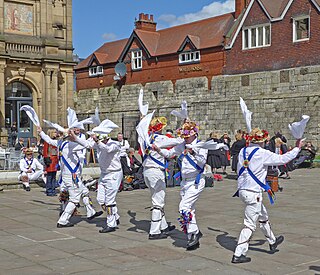
Morris dancing is a form of English folk dance. It is based on rhythmic stepping and the execution of choreographed figures by a group of dancers in costume, usually wearing bell pads on their shins and/or shoes. A band or single musician, also costumed, will accompany them. Sticks, swords, handkerchiefs, and a variety of other implements may be wielded by the dancers.
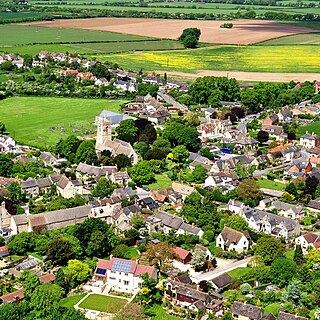
Oxfordshire is a ceremonial county in South East England. The county is bordered by Northamptonshire and Warwickshire to the north, Buckinghamshire to the east, Berkshire to the south, and Wiltshire and Gloucestershire to the west. The city of Oxford is the largest settlement and county town.

Wantage is a historic market town and civil parish in Oxfordshire, England. Although within the boundaries of the historic county of Berkshire, it has been administered as part of the Vale of White Horse district of Oxfordshire since 1974. The town is on Letcombe Brook, 8 miles (13 km) south-west of Abingdon, 24 miles (39 km) north-west of Reading, 15 miles (24 km) south-west of Oxford and 14 miles (23 km) north-west of Newbury.
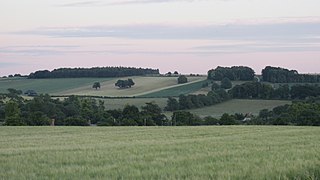
The Vale of White Horse is a local government district of Oxfordshire in England. It was historically part of Berkshire. The area is commonly referred to as the 'Vale of the White Horse'. It is crossed by the Ridgeway National Trail in its far south, across the North Wessex Downs AONB at the junction of four counties. The northern boundary is defined by the River Thames. The name refers to Uffington White Horse, a prehistoric hill figure.
Border Morris is a collection of individual local dances from villages along the English side of the Wales–England border in the counties of Herefordshire, Worcestershire and Shropshire. They are part of the Morris dance tradition.
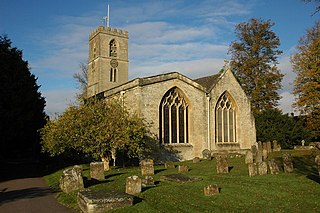
Charlbury is a town and civil parish in the Evenlode valley, about 6 miles (10 km) north of Witney in the West Oxfordshire district of Oxfordshire, England. It is on the edge of Wychwood Forest and the Cotswolds. The 2011 Census recorded the parish's population as 2,830.
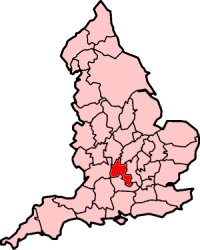
The county of Oxfordshire in England was formed in the early years of the 10th century and is broadly situated in the land between the River Thames to the south, the Cotswolds to the west, the Chilterns to the east and The Midlands to the north, with spurs running south to Henley-on-Thames and north to Banbury.
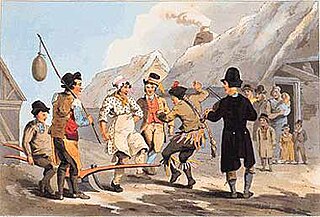
Plough Monday is the traditional start of the English agricultural year. Plough Monday is the first Monday after Epiphany, 6 January. References to Plough Monday date back to the late 15th century. The day before Plough Monday is referred to as Plough Sunday, in which a ploughshare is brought into the local Christian church with prayers for the blessing of human labour, tools, as well as the land.

Wantage was a constituency in Oxfordshire represented in the House of Commons of the Parliament of the United Kingdom.
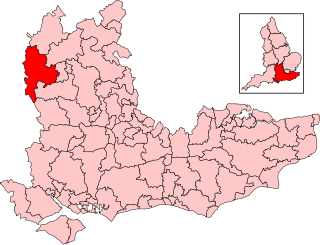
Witney is a county constituency in Oxfordshire represented in the House of Commons of the Parliament of the United Kingdom since 2016 by Robert Courts of the Conservative Party. It elects one Member of Parliament by the first-past-the-post system of election, and was created for the 1983 general election.

Folk plays such as Hoodening, Guising, Mummers Play and Soul Caking are generally verse sketches performed in countryside pubs in European countries, private houses or the open air, at set times of the year such as the Winter or Summer solstices or Christmas and New Year. Many have long traditions, although they are frequently updated to retain their relevance for contemporary audiences.

Ducklington is a village and civil parish on the River Windrush 1 mile (1.6 km) south of Witney in West Oxfordshire. The 2011 Census recorded the parish's population as 1,581.

Bampton, also called Bampton-in-the-Bush, is a settlement and civil parish in the Thames Valley about 4+1⁄2 miles (7 km) southwest of Witney in Oxfordshire. The parish includes the hamlet of Weald. The 2011 Census recorded the parish's population as 2,564. Bampton is variously referred to as both a town and a village. The Domesday Book recorded that it was a market town by 1086. It continued as such until the 1890s. It has both a town hall and a village hall.

Stanton Harcourt is a village and civil parish in Oxfordshire about 4 miles (6.4 km) southeast of Witney and about 6 miles (10 km) west of Oxford. The parish includes the hamlet of Sutton, 1⁄2 mile (800 m) north of the village. The 2011 Census recorded the parish's population as 960.

Childrey is a village and civil parish about 2+1⁄2 miles (4 km) west of Wantage in the Vale of White Horse. The parish was part of the Wantage Rural District in Berkshire until the 1974 boundary changes transferred the Vale of White Horse to Oxfordshire. The 2021 Census recorded the parish population as 527.
Mummer's Day, or "Darkie Day" as it is sometimes known, is a traditional Cornish midwinter celebration that occurs every year on Boxing Day and New Year's Day in Padstow, Cornwall. It was originally part of the pagan heritage of midwinter celebrations that were regularly celebrated throughout Cornwall where people would take part in the traditional custom of guise dancing, which involves disguising themselves by painting their faces black or wearing masks.
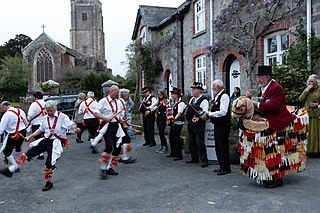
Dartington Morris are a dance troupe based in Dartington, near Totnes, Devon, England. The group formed as a men's dance side in 1968 at Dartington Hall and is a member side of the Morris Ring. They are a very active side and perform throughout the summer months, starting typically with a May Day dance at dawn and finishing around mid-September. The normal venues for dance are in and around the South Hams of Devon, brightening up the local life with fine performances, followed by great music and song. Dartington Morris was particularly well known for their active Young Morris side, with boys aged between 8 and 14 - a great example of keeping the Morris tradition alive.
The Hong Kong Morris is an English morris dancing team or side founded in Hong Kong in 1974. The side now has two chapters, the Hong Kong Morris and the Hong Kong (UK) Morris, colloquially known as The Brackets, in the United Kingdom. In its heyday, in the late 1980s and early 1990s, the Hong Kong Morris was one of the largest Cotswold morris sides in the world. The side maintains that it is committed to the principles of multiculturalism and inclusivity, and has always encouraged a multicultural membership and mixed dancing. The return of the former British colony of Hong Kong to China in 1997 has had no effect on the side's activities, and it continues to flourish as a notable example of the resilience of Western cultural activity in postcolonial Hong Kong.
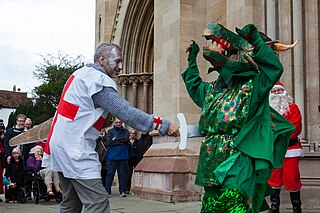
Mummers' plays are folk plays performed by troupes of amateur actors, traditionally all male, known as mummers or guisers. Historically, mummers' plays consisted of informal groups of costumed community members that visited from house to house on various holidays. Today the term refers especially to a play in which a number of characters are called on stage, two of whom engage in a combat, the loser being revived by a doctor character. This play is sometimes found associated with a sword dance though both also exist in Britain independently.